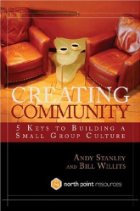
I have read only chapter one of Creating Community: 5 Keys to Building a Small Group Culture by Andy Stanley and Bill Willits. And I am looking forward to completing it. When I picked it up, something on the book’s back cover caught my attention and began to make my imagination work overtime. Here is what it said (I added the phrase in the brackets):
Imagine a network of small groups [or Sunday School classes] that actually multiply every twelve to twenty-four months.
Imagine a network of small groups [or Sunday School classes] led by men and women who truly understand their role as shepherd and facilitator.
Imagine a church model that quickly integrates nearly every member into a dynamic, committed small group [or Sunday School class].
One of my goals for The Sunday School Revolutionary! is to stretch readers’ thinking about Sunday School/small group ministry. One of my goals is for pastors, staff, and Sunday School/small group leaders to become dissatisfied with the status quo. One of my goals is to paint pictures of the possible and to provide tools for taking steps in that direction.
That is why I had to share these three simple but powerful statements. Look back at them. Allow me to address each of those statements (admitting that I have not yet read the book):
- MULTIPLY EVERY 12-24 MONTHS. Having trouble figuring out how to get your current groups to do this? Don’t give up on them, but you don’t have to start there. You can simply start with one group: get multiplying into the DNA of this new group who will multiply within 24 months, and that will repeat itself with both groups multiplying within 24 months after that. If that repeats itself every 24 months for ten years, you will have thirty-two multiplying groups and 1,024 at the end of twenty years. WOW! Holding up that value/expectation, providing leader training, and coaching/holding accountable the group leader are essentials for multiplication continuing.
- ROLE AS SHEPHERD AND FACILITATOR. Paint a picture of the Sunday School or small group leader caring for the group and mobilizing the group to care for each other. Imagine doing life together. Imagine coming to one another’s aid in time of need. A group leader is so much more than a deliverer of content during a group session. Care for group members must seep from the pores of the leader into everything the leader does in the group session and between them. Such an environment is attractive. Connections are much more difficult to disengage. Group members recognize others along their paths who need that kind of relationships.
- INTEGRATES NEARLY EVERY MEMBER. In many churches, Sunday School and small groups are becoming an increasingly smaller percentage of worship attenders. What if the opposite were true? What if groups were becoming an increasingly larger percentage? What if groups actually began to involve more than worship and were feeding more and more worship attenders into worship? That is happening in some churches today. How could help worship attenders, guests, and even people in your community see the value of your groups? What could you do to ensure that every new member and interested guest finds a place in a group?
The possibilities boggle my mind. There is work to be done. But it is absolutely essential work. It is life-changing work. And it can be done. It is being done. It must be done. Pray. Imagine big change! Share the picture. Start the work. And don’t give up on the dream. Be revolutionary!
Leave a Reply